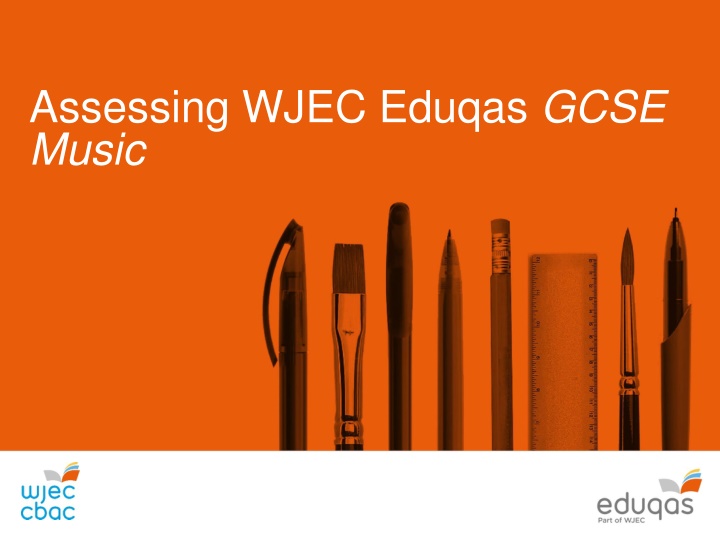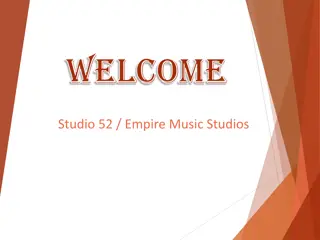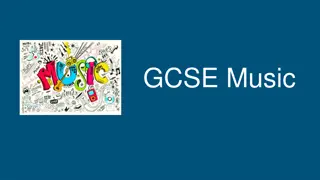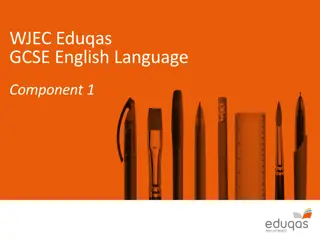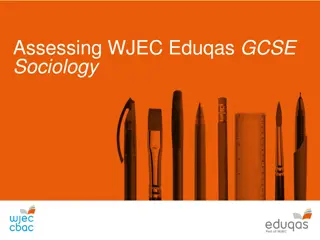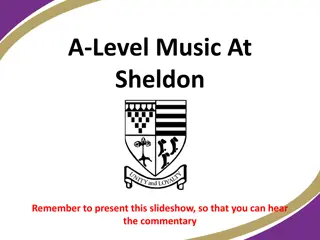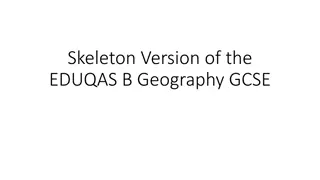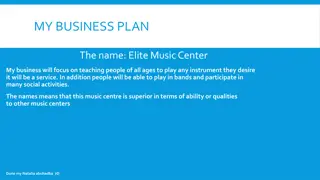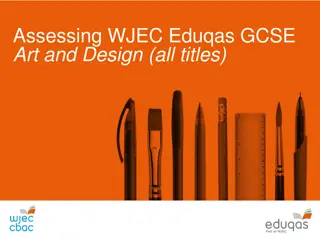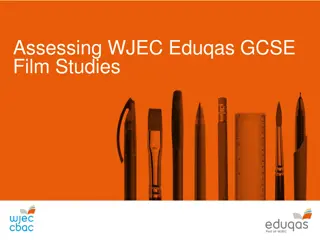Assessing WJEC Eduqas GCSE Music Criteria
Criteria for assessing evidence in WJEC Eduqas GCSE Music includes objective marking for low tariff responses and exercising academic judgement through levels of response mark schemes. Rubric infringements are also addressed consistently.
Download Presentation

Please find below an Image/Link to download the presentation.
The content on the website is provided AS IS for your information and personal use only. It may not be sold, licensed, or shared on other websites without obtaining consent from the author.If you encounter any issues during the download, it is possible that the publisher has removed the file from their server.
You are allowed to download the files provided on this website for personal or commercial use, subject to the condition that they are used lawfully. All files are the property of their respective owners.
The content on the website is provided AS IS for your information and personal use only. It may not be sold, licensed, or shared on other websites without obtaining consent from the author.
E N D
Presentation Transcript
Assessing evidence Understanding the assessment criteria Assessment criteria generally take two forms: objective marking generally for low tariff responses, where knowledge of objective information is being assessed the exercising of academic judgement via: an assessment grid setting out criteria for different levels of response indicative content, that is, an indication of the kind of content responses may include.
Assessing evidence Understanding the assessment criteria objective marking For questions assessing objective knowledge, the assessment criteria should be applied precisely. Marks should be awarded as indicated and no further subdivision made. Where the assessment criteria list points which may be included in students' answers, the list is not exhaustive and teachers should credit valid alternative responses which are not listed. In general, credit should be given according to the accuracy and relevance of students answers.
Assessing evidence Understanding the assessment criteria exercising academic judgement through levels of response mark schemes Firstly, identify the appropriate band a student s response falls into according to the criteria. Award a band where the student s response covers the majority of the criteria. Secondly, consider a mark in the centre of the band and then increase or decrease the mark depending on the quality of the answer, which may be reflected in the amount of indicative content covered. If a response falls between two bands, consider whether there are more characteristics of the higher or lower of the two bands and award accordingly. Indicative content is not exhaustive and other valid responses may be credited.
Assessing evidence Rubric infringements WJEC Eduqas has a consistent way of addressing rubric infringements. Below is a list of the possible infringements which sometimes occur for this qualification Type of infringement Answering more than the stipulated number of questions Action Mark all optional questions that the student has attempted. Determine which of the attempted routes through the rubric elicits the highest mark. Award highest mark. No marks awarded Ticking/indicating more than the stipulated number of answers (MCQs)
Assessing evidence Rubric infringements Type of infringement Answering with the wrong symbol, e.g. ticking instead of crossing, adding a word instead of the symbol provided Action Mark wrong symbol as though it were the correct symbol if it is used consistently throughout the question. If the student puts a mixture of symbols, and the intention is clear, award marks accordingly. If the intention is ambiguous, mark only the correct symbol, as per the question. If a word (from the choices provided with letters) is used instead of the letter, mark as for the letter associated with the word Where the correct answer has been clearly crossed out. If the student writes and then crosses out the correct answer, do not award the mark, even if no other answer is offered.
Assessing evidence Rubric infringements Type of infringement Action Where the question requires a set number of responses and the student has provided more (open ended knowledge and understanding questions) Mark all responses offered. Total the correct responses and award marks up to the maximum mark Where the question requires a set number of responses and the student has provided more (application of knowledge and understanding in a particular instance where there is a smaller number of correct answers) Mark the first response on each answer line
Assessing evidence Rubric infringements Type of infringement Writing answers in the wrong place (constrained papers) Action If it is obvious to which question the response relates, award marks as per the marking scheme
Assessing evidence Assessment Criteria Some questions are assessed objectively the answers are right or wrong. For the longer responses there is a banded marking scheme, such as this extract from 2019, Q6: The words highlighted describe the quality of the response required in each marking band. In each band the first sentence refers to the content of the response in relation to the question set, and the second to the use of specialist vocabulary. Begin by selecting the correct band for the content, and then consider the use of musical vocabulary, looking for the best fit.
Assessing evidence Characteristics of a successful response A successful response will contain a perceptive explanation of the features of the music, using correct musical terminology, referring in detail to aspects of the music heard and how this portrays the action. The exemplar provided within the 2018 and 2019 CPD materials contains a range of annotated responses, including a highly perceptive and detailed response. There is also an Exam Walk Through presentation which focuses on the longer answers and how these are assessed, available on the resources website.
Assessing evidence Characteristics of a less successful response A less successful response will contain little or no detail of the musical features. There will be little accurate use of musical terminology and few if any links made between the features of the music and the action it portrays. The exemplar provided within the 2018 and 2019 CPD materials contains a range of annotated responses, including a less successful response. There is also an Exam Walk Through presentation which focuses on the longer answers and how these are assessed, available on the resources website. For further information please see the principal examiner s reports.
Any Questions? If you have any questions, contact our specialist subject officers and administrative support team for your subject with any queries. music@eduqas.co.uk
